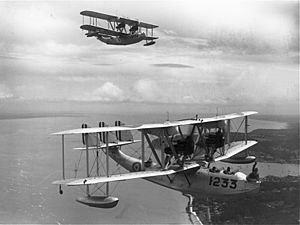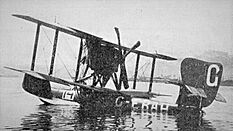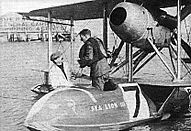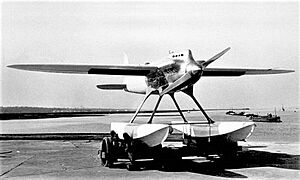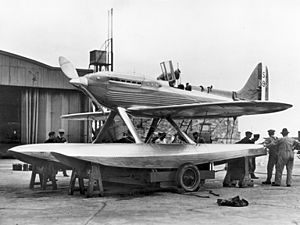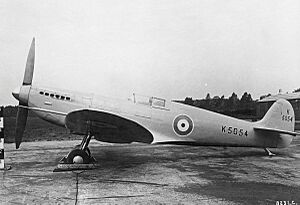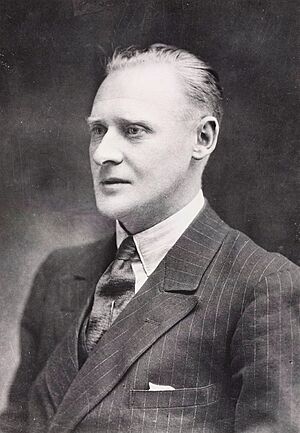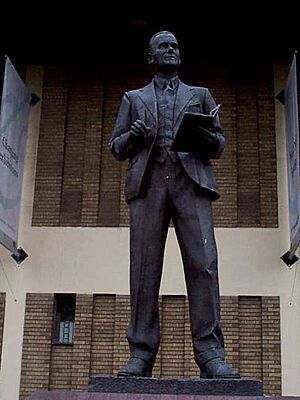R. J. Mitchell facts for kids
Quick facts for kids
R. J. Mitchell
CBE FRAeS
|
|
|---|---|
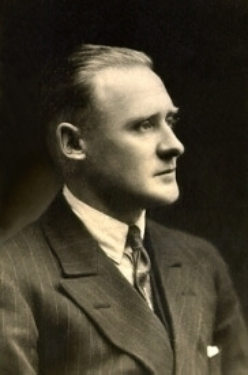 |
|
| Born |
Reginald Joseph Mitchell
20 May 1895 Butt Lane, Staffordshire, England
|
| Died | 11 June 1937 (aged 42) Southampton, Hampshire, England
|
| Occupation | Aircraft designer |
| Years active | 1916–1936 |
| Employer | Supermarine |
| Known for | Designer of the Supermarine S.6B and the Supermarine Spitfire |
| Children | 1 |
| Awards | |
| Signature | |
 |
|
Reginald Joseph Mitchell (20 May 1895 – 11 June 1937) was a brilliant British aircraft designer. He worked for the Southampton aviation company Supermarine from 1916 to 1936. He is most famous for creating fast racing seaplanes like the Supermarine S.6B. He also led the team that designed the legendary Supermarine Spitfire fighter plane.
Mitchell was born in Butt Lane, Staffordshire, England. He went to Hanley High School. After school, he trained as an apprentice at a factory that built locomotives. He also studied engineering and math at night. In 1917, he moved to Southampton to join Supermarine. He became the Chief Engineer in 1920 and Technical Director in 1927. Between 1920 and 1936, he designed 24 different aircraft. These included flying boats, racing seaplanes, light aircraft, fighters, and bombers. From 1925 to 1929, he worked on racing seaplanes for the Schneider Trophy competition. His final design in this series was the Supermarine S.6B, which won the trophy in 1931. Supermarine then allowed Mitchell to start a new design, the Type 300, which later became the famous Spitfire.
In 1933, Mitchell had surgery for an illness. He kept working and even got his pilot's licence in 1934. But in early 1937, his illness returned, and he had to stop working. He passed away that year. Joseph Smith took over as Supermarine's chief designer after him.
Contents
- Early Life and School Days
- Working at Supermarine
- Illness and Final Years
- Honors and Legacy
- His Personality
- See also
Early Life and School Days
Reginald Joseph Mitchell was born on May 20, 1895, in Butt Lane, Staffordshire, England. He was the second of five children. His father, Herbert Mitchell, was a headmaster at schools in the Stoke-on-Trent area. Later, his father helped start a printing business. Reginald's mother, Eliza Jane Brain, was the daughter of a cooper. When Reginald was a child, his family lived in Normacot, a part of Stoke-on-Trent.
Reginald, known as "Reg" to his family, went to Queensberry Road Higher Elementary School. Then he moved to Hanley High School. There, he became very interested in building and flying model aircraft. In 1911, at age 16, he left school. He started an apprenticeship at Kerr Stuart & Co. in Fenton, a factory that built railway engines. After his training, he worked in the drawing office at Kerr Stuart. He also studied engineering and math at a local college, where he showed a great talent for mathematics.
In 1916, Mitchell left Kerr Stuart. For a while, he worked as a part-time teacher. He tried to join the armed forces twice, but he was turned down both times because he was a trained engineer.
Working at Supermarine
Starting His Career and Promotions
In 1916, Mitchell joined the Supermarine Aviation Works in Southampton. Since it started in 1912, Supermarine had focused on building flying boats. Their first aircraft, the Pemberton-Billing P.B.1, was made in 1914. During World War I, the British Government took over Supermarine. At this time, the company made the first British single-seat flying boat fighter, called the Supermarine Baby.
When Mitchell joined Supermarine, he got to try out different jobs. This helped him gain experience in the aircraft industry. His engineering background helped him switch from working with locomotives to understanding airplanes. Mitchell was good at math and could think creatively. His ability to use his intuition when designing was quickly noticed. Records show he worked as a draughtsman in 1916. By 1917, he was helping the company's owner and designer, Hubert Scott-Paine. He probably helped develop the Baby, which was changed for racing in 1919 and renamed the Supermarine Sea Lion.
In 1918, Mitchell was promoted to assistant works manager. When Supermarine's chief designer left in 1919, Mitchell took over. He led a team that had six draughtsmen and a secretary in 1918. After his promotion, the 19-year-old Mitchell went back to Staffordshire and married Florence Dayson. She was an infant school headmistress. By 1921, he was Supermarine's chief engineer. When Scott-Paine left in 1923, Mitchell got a new contract. This gave him more power in the company. His 10-year contract showed how important he was to Supermarine.
It's not clear how Mitchell got promoted so quickly at such a young age. Few documents from his early career still exist. However, quick promotions were not unusual back then. Other young men held similar jobs in other aircraft companies. Decades after his death, former Supermarine colleagues who knew Mitchell did not want to share many personal memories of him.
Aircraft Designs in the 1920s
Between 1920 and 1936, Mitchell designed 24 airplanes. His early projects often involved changing Supermarine's older aircraft. In June 1920, the Air Ministry announced a competition for civilian aircraft. Supermarine's entry was the Supermarine Commercial Amphibian. This was Mitchell's adaptation of the company's Supermarine Channel. The Amphibian came in second, but it was judged the best in design and reliability. His redesigned Supermarine Baby, renamed the Supermarine Sea King, was shown at the Olympia International Aero Exhibition in 1920. This was the first international exhibition in the UK after World War I. In 1922, the Chilean government bought a Channel plane, modified by Mitchell. That year, he redesigned a version of the Commercial Amphibian, called the Supermarine Sea Eagle.
Mitchell created new aircraft designs early in his career. He designed the Supermarine Seal II in 1920. The next year, he designed the triplane Flying Boat Torpedo Carrier. The historian Ralph Pegram says the unbuilt Torpedo Carrier shows the "first true indication of Mitchell's thoughts as a designer." In 1921, work began on the Supermarine Swan, a commercial carrier, but only one prototype was built. The Supermarine Seagull II—which was later used for future designs—started getting orders in 1922. Mitchell designed the Amphibian Service Bomber in 1924. It was renamed the Supermarine Scarab. The Spanish Navy bought 12 of these aircraft, and they were used until 1928.
Supermarine's first design for a land aircraft was the Supermarine Sparrow. It did not win the Air Ministry's Light Air Competition in 1924 and did not get any orders. A different version, the Supermarine Sparrow II, was used by Mitchell to test his different airfoil designs.
Work on the Supermarine Southampton began in March 1924. It flew for the first time the following March and started service in July 1925. By the end of 1925, Mitchell's team had designed the Southampton II. This was a Southampton with a metal hull. The new plane was more powerful, lighter, and stronger. It first flew in 1927. Mitchell wrote a paper about the Southampton, which appeared in the March 1926 issue of Flight magazine. In 1928, a group of Supermarine Southampton IIs flew from Felixstowe to Australia and back. This trip gave Mitchell's design team important information about flying aircraft in hot, tropical areas. The Southampton was one of the most successful flying boats between the two World Wars. It helped make Britain a leader in designing aircraft for the sea. It was used by six RAF squadrons until 1936.
In 1926, the Air Ministry asked for new fighter aircraft. Mitchell's design team, which he had reorganized that year, responded with several designs. These included the Single Seat Fighter. By this time, Supermarine was moving away from wooden amphibious aircraft. The company focused on designing larger metal flying boats. One example was the 3-Engined Biplane Flying Boat, designed in November 1927. The Supermarine Air Yacht and a new design, the Southampton X, were ordered in June 1928. Mitchell stopped using complicated curved surfaces for the wings and hulls of the Air Yacht and Southampton X. Because of this, these aircraft looked more "boxy."
A request from the Air Ministry in 1928 led to Supermarine designing a six-engined flying boat. One of Mitchell's designs for this was very different. It had a new 140 feet (43 m) cantilever wing with a large surface area. This aircraft was never built. From 1929 to 1931, he continued to design aircraft based on the Southampton and Southampton X. These included the Supermarine Sea Hawk, the Type 179, the Nanok, and the Seamew.
New Designs and Patents (1929–1934)

In February 1929, Mitchell filed a patent for "Improvements in the Cooling System of Engines for Automotive Vehicles." This was a condenser to be placed inside the wings of an aircraft. The Air Ministry rejected Supermarine's idea for such a wing-cooled aircraft. However, in May 1929, a new specification allowed Mitchell to use his ideas again. He submitted a similar patent in 1931. The condenser was used in the Type 232, made in April 1934, but it was never officially offered for sale.
In the early 1930s, many of Mitchell's ideas did not go past the early design stages. The company tried to sell a 5-engined flying boat, but the contract was canceled in early 1932. This led to job losses and pay cuts at Supermarine. However, in 1933, the company's luck changed. They received an order for 12 Scarpas (which were previously the Southampton IV). This was the first contract for a new design by Mitchell since 1924. This order was followed by orders for the Supermarine Stranraer, which started production in 1937.
After the first Seagull V flew in June 1933, the Royal Australian Air Force became interested, and 24 planes were ordered. The same year, the RAF ordered 12 aircraft, now renamed the Supermarine Walrus. Following a new Air Ministry request, Mitchell worked on a redesigned version of the Walrus, called the Sea Otter. Work on the Sea Otter finished after Mitchell's death in 1937, and it first flew in September 1938.
In October 1934, Mitchell wrote an article in the Daily Mirror called 'What is happening now in Air Transport?'. In it, he predicted that air travel would become the safest way to travel.
Schneider Trophy Races (1922–1931)
Mitchell and his design team worked on a series of racing seaplanes. These planes were built to compete in the Schneider Trophy competition. His team included Alan Clifton, Arthur Shirvall, and Joseph Smith. These men were very important to Supermarine's success. The National Physical Laboratory (NPL) also gave valuable help and scientific advice. The competition helped make Mitchell a leader in aviation design.
Sea Lion Series (Early 1920s)
Mitchell improved the Supermarine Sea King II to create the Sea Lion II. This plane competed for the 1922 Schneider Trophy in Naples. The Sea Lion II won the race, flying at an average speed of 145.7 miles per hour (234.5 km/h).
Supermarine did not have enough time to design a new flying boat for the 1923 competition. So, they borrowed the Sea Lion II back from the Air Ministry for Mitchell to adapt it. He made it 10 knots (19 km/h; 12 mph) faster with help from D. Napier & Son, who provided a 525 horsepower (391 kW) Lion III engine. To reduce drag, Mitchell made the wingspan smaller, from 32 to 28 feet (9.8 to 8.5 m). He also changed the struts, floats, hull, and how the engines were fitted.
For the 1923 contest, two of the three British planes were badly damaged before the race. This left the Sea Lion III to compete alone. The United States team, flying Curtiss seaplanes, won the competition. The winning pilot, David Rittenhouse, reached a top speed of 177.27 miles per hour (285.29 km/h).
Supermarine S.4 (1925)
Even while the Sea Lion II was being changed at the Woolston factory, Mitchell was working on a new plane. Supermarine knew the American monoplane was the best design available then. The Supermarine S.4—named by Mitchell with "S" for Schneider—was a joint project with Napier. The Supermarine team had support from the Air Ministry and more freedom than US designers. The S.4 was called "his first outstanding success" after Mitchell's death. He used the experience from designing it to create its successor, the Supermarine S.5.
Mitchell knew he needed to reduce drag to increase speed. His new design was a mid-wing, cantilever floatplane. It was similar to a French monoplane, the Bernard SIMB V.2, which had broken the flight airspeed record in December 1924. The S.4 did not have the new surface radiators, which were not available yet. But it was very aerodynamic and looked good. Trial speeds reached 226.742 miles per hour (364.906 km/h), which caused a sensation in the press.
The S.4 crashed before the 1925 race. The reasons were never fully known. On the day of the navigation trials, it stalled and fell into the sea from 100 feet (30 m). When the pilot Henri Biard was rescued, Mitchell, who was on the rescue boat, jokingly asked the injured man: "Is the water warm?"
1926 and 1927 Competitions

The Air Ministry and other aviation groups decided not to compete for the Schneider Trophy in 1926. But Mitchell confirmed that Supermarine would be ready for the next race. His work at the NPL started in November that year. From wind tunnel tests at the NPL, he learned that the S.4's radiators caused a third of the aircraft's total drag. Without them, it would have been the most streamlined aircraft in the world. British aircraft companies planned to enter the 1926 race. However, the Air Ministry's requirements meant no aircraft could be finished and tested in time.
Two Supermarine S.5 seaplanes entered the 1927 contest in Venice. Mitchell understood that a monoplane with two floats created less drag than any other aircraft of its time. wind tunnel tests at the NPL convinced him that the cantilever wing design was too heavy and should not be used. The NPL also showed that flat-surfaced skin radiators reduced drag better than the ridged ones preferred by American designers. So, Mitchell used them to improve the S.5. He made the fuselage cross-section 35 percent smaller than the S.4's. He even complained that RAF pilots were too big to fit into the S.5's cockpit! The fuselage skin was made thinner using duralumin.
The two Supermarine S.5s were the only seaplanes to finish the race. They came in first and second. The Italian dictator Benito Mussolini and a huge crowd watched from the Venice Lido. The third British entry, a Gloster IV, and the three Italian competitors flying Macchi M.52s, had to drop out.
Mitchell had joined the RAeS in 1918. In 1927, he received the society's Silver Medal. At the end of that year, he became the Technical Director at Supermarine. When Vickers Ltd took over Supermarine in 1928, Mitchell remained as chief designer. One of the conditions of the takeover was that he stay as a designer for the next five years.
Supermarine S.6 (1929)

Interest in the competition decreased after the 1927 race. There was no competition the next year. The Fédération Aéronautique Internationale was convinced by the Royal Aero Club to hold races every two years.
Mitchell believed a more powerful engine than the Napier Lion was needed for future contests. The Air Ministry asked Rolls-Royce Ltd to design a new engine specifically for Supermarine's new seaplane, the S.6. Rolls-Royce had to produce an engine quickly that matched the S.6's streamlined shape. They used the partially developed 825 horsepower (615 kW) Buzzard. Mitchell had to change some of his design to fit the heavier engine. For example, he moved the front float struts and redesigned the engine cowling. The Air Ministry ordered two S.6 seaplanes, both built by August 1929. Mitchell made changes to the seaplanes so the engines could be used at full power. Problems were found: the radiators were not good enough, high engine torque made the S.6 turn in circles, and the centre of gravity was in the wrong place.
The 1929 race at Calshot was won by Supermarine with the S.6. It reached an average speed of 528.89 km/h (328.64 mph). Three of the four new aircraft were from the UK. The older Italian Macchi M.52R came second, and Supermarine's backup S.5 took third place.
Supermarine S.6B (1931)
Britain's final entry in the series, the Supermarine S.6B, was the peak of Mitchell's goal to "perfect the design of the racing seaplane." A rich philanthropist, Lady Houston, paid for it. She donated £100,000 after the British Government decided not to enter an RAF team for the 1931 contest.
Mitchell decided to design an improved version of the S.6, making as few changes as possible. The improvements included a more powerful engine. He also planned for the increased heat and torque from the engine, and the larger amounts of cooling oil and fuel needed. The S.6B was a bigger seaplane than the S.6. It needed a more efficient cooling system and a stronger frame.
The S.6B successfully completed the course and won the 1931 race. The Schneider Trophy rules said that the contest would end when one country won the trophy three times in five years. So, the S.6B's victory meant Britain won the contest for good. The aircraft then broke the world air speed record, reaching 407.5 miles per hour (655.8 km/h) that year. Mitchell was awarded the Commander of the Most Excellent Order of the British Empire (CBE) on December 29, 1931, for his work with the Schneider Trophy contest.
Type 224 Fighter Plane
In 1930, the Air Ministry asked for a new fighter aircraft that could be used day and night. Mitchell's design, the Type 224, was one of three monoplane designs made into prototypes for the Air Ministry. The final design had an open cockpit, four Vickers machine guns, and a 660 horsepower (490 kW) Rolls-Royce Goshawk engine. It also had fixed landing gear. An inverted gull wing was included because of the engine's cooling system needs. The wing did not have flaps, which were needed for the aircraft to land safely.
Unofficially called the Spitfire, the Type 224 first flew in February 1934. The aircraft looked awkward and was not efficient. This was partly because the cooling system failed to stop the engine from getting too hot. The RAF decided that the Type 224's performance was not good enough. They chose the Gloster Gladiator instead.
The Supermarine Spitfire
While the Type 224 was still being built in 1933, Mitchell was already designing the Type 300. This would become his most famous work, the Supermarine Spitfire. He made the Type 224 design much better. He used the same engine but added shorter wings and landing gear that could be pulled up into the plane. The Air Ministry first rejected Mitchell's design. But he changed it, making the wing thinner and shorter. He also included the new Rolls-Royce Merlin engine and an innovative new cooling system. This showed he was willing to use good ideas from other people.
For a short time, the design work continued with private money. But in December 1934, the Air Ministry hired Supermarine to build a prototype based on Mitchell's design. Mitchell did not like that the Air Ministry insisted the Spitfire be changed to have a tail wheel. At the time, he wasn't told that the government had decided to build hard surface runways for the RAF for a future war. This decision meant the tail wheel change was necessary.
The prototype, called K5054, first flew on March 6, 1936, at Eastleigh, Hampshire. Mitchell watched the flight. Even though he was ill, he traveled to Eastleigh during the flight tests for K5054. In June 1936, before the prototype had finished its trials, the Air Ministry ordered 310 Spitfires.
Many of the Spitfire's technical improvements came from people other than Mitchell. The thin elliptical wings were designed by the Canadian aerodynamicist Beverley Shenstone. The Spitfire also had similarities to the Heinkel He 70 Blitz. The under-wing radiators were designed by the Royal Aircraft Establishment. monocoque construction was first developed in the United States. Mitchell's great achievement was combining all these different ideas into one single design. This came from his amazing skill in high-speed flight and his brilliant engineering ability. He used important lessons learned from Supermarine's unsuccessful Type 224 fighter. The quality of his design allowed the Spitfire to be constantly improved throughout World War II.
Illness and Final Years
In 1933, Mitchell had surgery for an illness that left him permanently disabled. Despite this, he kept working on the Spitfire and a four-engined bomber, the Type 317. It was unusual for an aircraft designer back then, but he took flying lessons. He got his pilot's licence and flew solo for the first time in July 1934.
In 1936, Mitchell was diagnosed with cancer again. In early 1937, his illness forced him to stop working. His assistant, Harold Payn, led the design team at Supermarine in his absence. Mitchell flew to Vienna for special treatment and stayed there for a month. But he returned home after the treatment did not work. He died at home in Highfield, Southampton, on June 11, 1937, at the age of 42.
The quality of the flying boats Mitchell designed for the RAF made him the top aircraft designer in Britain. His obituary in The Journal of the Royal Aeronautical Society in 1937 called him "brilliant" and "one of the leading designers in the world." The Society praised him, saying he was "a quiet, subtle, not obvious genius" who had "an intuitive capacity for grasping the essentials, getting to the point and staying there." Joseph Smith, who became Chief Designer at Supermarine after Mitchell's death, said that Mitchell "was an inveterate drawer on drawings... [which were] usually accepted when the thing was redrawn."
Honors and Legacy
Mitchell's life was shown in the 1942 British film The First of the Few. He was played by Leslie Howard, who also produced and directed the movie.
The Mitchell Memorial Youth Theatre, now called Mitchell Arts Centre, opened in Stoke-on-Trent in 1957. Over £50,000 was raised by the public to build it. Butt Lane Junior School was renamed Reginald Mitchell County Primary School in 1959. Hanley High School was renamed Mitchell High School in 1989. The R J Mitchell Primary School at Hornchurch, which opened in 1968, is also named in his honor. Supermarine Spitfires flown by pilots from different countries flew from RAF Hornchurch.
In 1986, Mitchell was added to the International Air & Space Hall of Fame at the San Diego Air & Space Museum. The American helper Sidney Frank revealed a statue of Mitchell at the Science Museum, London, in 2005. The slate drawing board surface shows a drawing of the prototype Spitfire from June 1936. The stone sculpture was made by Stephen Kettle and given to the museum by the Sidney E. Frank Foundation.
There are plaques dedicated to Mitchell at his home in Southampton and where he was born in Butt Lane. Papers about his work at Supermarine are kept at the archives of the Royal Air Force Museum London.
A bronze statue of Mitchell was unveiled in Hanley, Stoke-on-Trent, on May 21, 1995. The statue, made by Colin Melbourne, was ordered by Stoke-on-Trent City Council. It stands outside The Potteries Museum & Art Gallery. The statue shows Mitchell wearing a suit, holding a pen in his right hand and a book in his left.
The Potteries Museum & Art Gallery, in Hanley, Stoke-on-Trent, has a Mark XVI Spitfire (RW388). The RAF gave it to Stoke-on-Trent in 1972 to honor the city's connection to Reginald Mitchell.
Southampton City Art Gallery has an oil painting of Mitchell, painted in 1942 by Frank Ernest Beresford.
His Personality
Mitchell was a quiet and humble person. He did not like giving public speeches or presenting papers. One person from his department said, "he said nothing unless there was something worth saying." He avoided public attention and was not widely known until after his death.
According to his son Gordon, Mitchell did not like being told what to do or following strict routines at work. He could be short-tempered and "a difficult man to live with sometimes." He often had a lot of freedom at Supermarine. He was a strict boss but struggled with the organization needed for a company like Supermarine. When the engineer Barnes Wallis was hired to make Mitchell's department more efficient in 1930, Wallis had to be moved because their personalities clashed. The ODNB describes Mitchell as very talented and smart. But he was "often stern and irritable towards those less gifted than himself." He cared deeply for his staff at Supermarine, showing them kindness and humanity. In return, they were loyal and fond of him.
See also
 In Spanish: R. J. Mitchell para niños
In Spanish: R. J. Mitchell para niños





